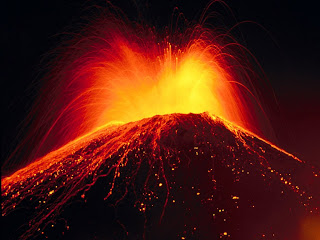Volcano is a mountain or hill, which is formed by the accumulation of materials such as hot, molten rock, and ash erupted through one or more openings, which is called volcanic vents, in the earth's surface. Their formation can be attributed to the movement of plates and the existence of mantle plumes.
The word volcano comes from the little island of Vulcano in the Mediterranean Sea off Sicily. Centuries ago, the people living in this are believed that Vulcano was the chimney of the forge of Vulcan-- the blacksmith of the Roman gods. They thought that the hot lava fragments and clouds of dust erupting from Vulcano came from Vulcan's forge as he beat out thunderbolts for Jupiter, king of the gods, and weapons for Mars, the god of war. In Polynesia, the people attributed eruptive activity to the beautiful but wrathful Pele, Goddess of Volcanoes, whenever she was angry or spiteful.
About 1,900 volcanoes are active today or known to have been active in historical times. Almost 90 percent of the volcanoes are found in the Ring of Fire, a band of Volcanoes circling the edges of the Pacific Ocean.
Volcanic eruptions bring both hazards and benefits to people. For example, while lava flows can be highly destructive, they also provide fertile soils for agriculture. They can also build new land, as they have in Hawaii.
Next entry: Formation of Volcanoes



No comments:
Post a Comment